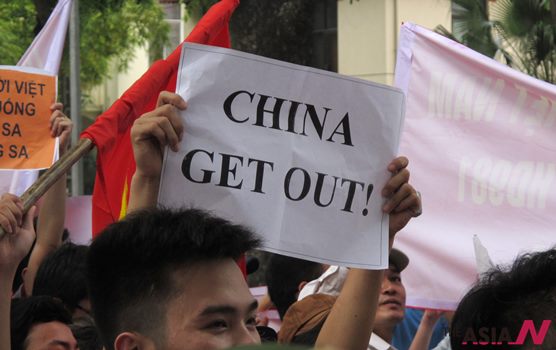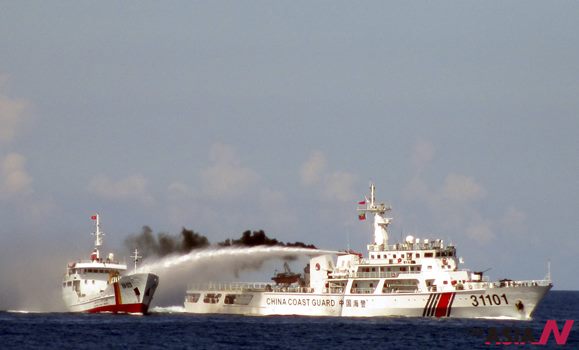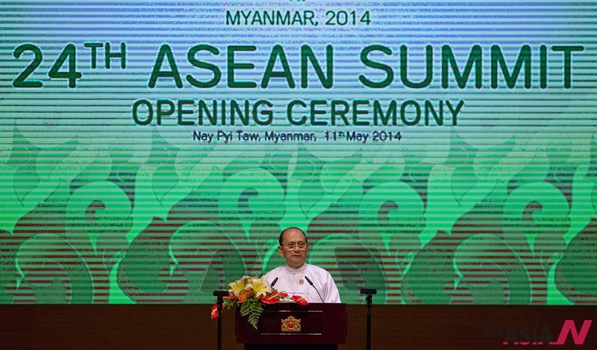
Tensions in South China Sea mounting over Chinese oil rigs (1)
Vietnam and Philippines directly involved, ASEAN countries cautious
Amid physical clashes, calls for peaceful resolution rising
An “inescapable” maritime dispute between China vis-a-vis Vietnam and the Philippines flared up in the South China Sea over China’s recent setting up of oil rigs, leading to China’s firing of water cannons and Vietnam’s appeal for patriotism movement. The stocks in the Vietnamese markets fell, reflecting in part instability of the region.
The ASEAN summit first held in Myanmar over the weekend has issued a statement appealing for peaceful resolution of the conflict and the head of the United Nations also urged one. However, it really remains to be seen whether this clash could be solved peacefully, given that China has started its assertiveness in this Asian region.
In the spat over the maritime sovereignty, the Philippines is also embroiled by arresting Chinese fishermen on charges of fishing in the “Filipino” waters. In the past, the Vietnamese fought two naval skirmishes against the Chinese since 1974, and this conflict over maritime sovereignty has deep historical roots, going as far back as 1000 years.

Chinese ramming Vietnamese ships to “protect own oil rig”
The standoff started May 1, when China moved deep sea oil rigs into waters close to the Paracel Islands(Hoangsha, Xisha) in what most analysts believe was an especially assertive move to help cement its claims of sovereignty over the area. Vietnam, which says the islands belong to it, dispatched its ships immediately. Even fighter planes were flown over the region.
On May 7, Vietnam said Chinese vessels had repeatedly rammed and fired water cannons at its ships, damaging several of them, and showed video footage of the incidents. China argues it is doing nothing wrong, and said it will continue with its drilling activities in the area.
China has been increasingly pressing its claims in the South China Sea, which it claims to be theirs almost in its entirety. This brought it into conflict with Vietnam and the Philippines, which also claims parts of the water, as do Malaysia, Brunei, and Taiwan. The United States’ position is that it doesn’t take sides in the dispute, but it too shares regional concerns about China’s growing clout. it has criticized Beijing’s latest move as “provocative.”

ASEAN leaders cautious over maritime dispute
Amid the growing row between China versus Vietnam and the Philippines, Southeast Asian leaders expressed “serious concerns” over territorial disputes in the South China Sea. The 10-member ASEAN leaders issued a statement on May 11, after concluding its summit, reading “We expressed serious concerns over the ongoing developments in the South China Sea.”
The statement called on all parties involved to exercise self-restraint, not to resort to threats or use of force, and to resolve disputes by peaceful means in accordance with universally recognized principles of international law.
The statement marks a change of tone and it is a rare level of consensus on the vexed sea rights issue. However, the fact that “no concrete country” was mentioned implies that ASEAN leaders other than parties concerned used caution in expressing their positions. This could be construed that China has lots of influence over these leaders.

Thousands of patriotic Vietnamese protesting against China
As news spread that Chinese ships rammed and fired water cannons and that some of Vietnamese were wounded, the Vietnamese went on a patriotic movement nationwide and overseas. In cities across the country, the Vietnamese staged demonstrations demanding Chinese to remove the oil drilling rig. Vietnamese living overseas demonstrated in front of Chinese embassies in their resident countries.
Vietnamese say that the Chinese drilling rigs were located within Vietnam’s exclusive economic zone and continental shelf. Thus China was seriously violating international law, 1982 UN Convention on the Law of the Sea(UNCLOS), and a 2011 agreement on settlement of sea-related issues.
Vietnamese media report on Chinese “illegal” acts
Vietnamese became “infuriated” at the Chinese installment of illegal oil rigs and intentional ramming of Vietnamese ships. Vietnamese news media, for example, a daily named Viet News carried lots of stories about this maritime row : “Japan, UK call for de-escalation of East Sea tensions” “Nation protests Chinese intrusion” “Overseas Vietnamese protest China’s violation of sovereignty” and so forth.
Vietnam News also reported that the maritime tensions keep stock indices down. One editorial said that the Chinese must withdraw its oil rig. Vietnamese position appears to be that it will take all necessary measures, preferably diplomatic, to protect its waters.


